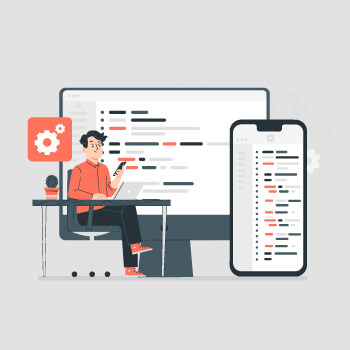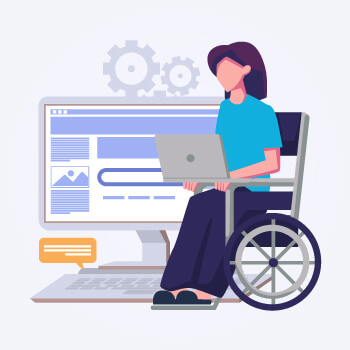- Why Automated Accessibility Testing is Important for Businesses?
- Multi-Platform Challenges and Solutions
- How Automated Accessibility Testing Enhances User Experience?
- Overall Impact of Accessibility Testing on User Experience
- Conclusion
- How can TestingXperts help you with Automated Accessibility Testing?
In the ever-evolving digital landscape, ensuring digital accessibility is an ethical imperative and a cornerstone of providing an inclusive and seamless user experience. As websites and applications become increasingly complex, manual accessibility testing can be time-consuming, prone to oversight, and challenging to scale effectively. This is where automated accessibility testing emerges as a transformative ally, playing a pivotal role in identifying and rectifying potential barriers for users with diverse needs.
In this exploration of accessibility, we delve into the significance of automated testing tools, their capabilities in adhering to standards such as the Web Content Accessibility Guidelines (WCAG), and how they contribute to a web ecosystem that prioritizes universal usability. Join us on a journey through the intricacies of automated accessibility testing and discover its crucial role in crafting digital environments that truly cater to the needs of all users.
Why Automated Accessibility Testing is Important for Businesses?

Automated accessibility testing is a critical component for businesses committed to delivering inclusive digital experiences. In an era where online presence is fundamental to success, ensuring that websites and applications are accessible to users of all abilities is not just a legal requirement but a strategic imperative. Automated testing tools provide businesses with a scalable and efficient means of identifying and addressing accessibility issues throughout the development process. By automating these tests, organizations can streamline their workflows, reduce development time, and minimize the risk of overlooking critical accessibility considerations.
Moreover, as the global market becomes increasingly diverse, accessibility is a key factor in expanding reach and resonating with a broader audience. Studies indicate that consumers are more likely to engage with and trust businesses that prioritize inclusivity. In essence, automated accessibility testing is not just a compliance checkbox; it is a strategic investment that fosters efficiency, inclusivity, and a positive brand image in an ever-evolving digital landscape.
Here are some of the major benefits of Accessibility Testing for Businesses Listed:
Expanded Market Reach
According to the World Health Organization, approximately 15% of the world’s population lives with a disability. By making digital assets accessible, businesses can potentially reach over a billion people who might face barriers. Thus, businesses that prioritize accessibility testing can tap into a larger consumer base by ensuring their digital products and services are usable by people with diverse abilities.
Enhanced User Engagement and Satisfaction
A study by the WebAIM Million analysis found that over 98% of the top 1 million home pages had detectable WCAG 2 failures. By addressing these issues through accessibility testing, businesses can enhance user satisfaction and retain customers, as 88% of online consumers are less likely to return to a site after a bad experience. It can thus lead to improved user experiences, fostering increased customer satisfaction and loyalty.
Risk Mitigation and Legal Compliance
The number of web accessibility-related lawsuits has been on the rise, with a 23% increase in 2020 compared to the previous year. By proactively addressing accessibility issues through testing, businesses can reduce the likelihood of legal challenges, safeguarding their reputation and financial stability. It helps businesses mitigate the risk of legal repercussions associated with inaccessible digital content and ensures compliance with accessibility regulations.
Multi-Platform Challenges and Solutions

In an era where digital experiences span across various platforms and devices, ensuring accessibility is a multifaceted challenge for businesses. Automated accessibility testing, while a powerful tool, encounters unique hurdles in the realm of multi-platform development. Here, we explore the challenges associated with ensuring accessibility across diverse platforms and propose solutions to address these complexities.
Problem Area |
Challenge |
Solution |
|
Integration with Development Workflows |
Integrating automated accessibility testing seamlessly into diverse development workflows, including web, mobile, and desktop, can be complex and time-consuming.
|
Opt for testing tools that integrate well with popular development environments and continuous integration/continuous deployment (CI/CD) pipelines. This ensures that accessibility testing becomes an integral part of the development lifecycle, reducing the risk of accessibility issues creeping in at later stages.
|
|
Native App Accessibility
|
Ensuring accessibility in native mobile applications poses unique challenges, as automated tools developed for web environments may not be directly applicable.
|
Utilize specialized automated testing tools designed for native mobile platforms. These tools can assess mobile-specific accessibility features and provide insights into how users with disabilities interact with mobile applications.
|
|
Platform Diversity Challenges
|
Different platforms (web, mobile, desktop) often have distinct accessibility requirements and guidelines, making it challenging to maintain consistency in testing.
|
Implement a comprehensive testing strategy that incorporates specialized tools for each platform, ensuring adherence to platform-specific accessibility standards. This approach ensures that the user experience is consistently accessible across various devices and interfaces.
|
|
Responsive Design and Dynamic Content
|
Responsive design and dynamic content can present challenges for automated tools, as they may struggle to accurately assess accessibility in real-time or across various screen sizes.
|
Combine automated testing with manual testing to address dynamic content effectively. Implement automated testing tools that support responsive design testing and leverage scripting for dynamic elements. Additionally, consider using real user monitoring to capture actual user experiences across different platforms.
|
|
Cross-Browser Compatibility
|
Variations in browser behavior can impact the consistency of accessibility features, necessitating testing across multiple browsers.
|
Select automated testing tools that support cross-browser compatibility testing. This ensures that accessibility features are consistent across different browsers, providing a uniform experience for users regardless of their chosen browser.
|
How Automated Accessibility Testing Enhances User Experience?

Prioritizing accessibility doesn’t just cater to a specific segment of users; it elevates the overall user experience for everyone. Businesses that embrace accessibility foster a culture of inclusivity, creating digital environments that are not only compliant with standards but also intuitive, efficient, and positively perceived by a broad and diverse user base.
Inclusive Design Fosters User Satisfaction
Accessibility initiatives focus on inclusive design principles, ensuring that digital experiences cater to users with diverse abilities. By accommodating a wide range of needs, businesses create a more welcoming and user-friendly environment, leading to increased user satisfaction.
Improved Navigation for All Users
Accessible design often involves clear and logical navigation structures. While this is crucial for users with disabilities, it benefits all users by making interfaces more intuitive and efficient. Well-structured navigation enhances the overall user experience by reducing confusion and streamlining the user journey.
Enhanced Usability Across Devices
Accessibility measures often result in responsive and adaptable designs, ensuring that content is accessible on various devices and screen sizes. This not only accommodates users with disabilities who may use different assistive technologies but also provides a consistent and enjoyable experience for all users, regardless of the device they choose.
Faster Loading Times and Performance
Optimizing accessibility often involves improving the underlying code and content structure. These optimizations can contribute to faster loading times and improved performance. This not only benefits users with slower internet connections or limited bandwidth but also enhances the overall user experience for everyone by delivering content more swiftly.
Positive Impact on Brand Reputation
Demonstrating a commitment to accessibility reflects positively on a brand. Users appreciate businesses that prioritize inclusivity, and this commitment can contribute to a positive brand image. According to a WebAIM survey, 71.3% of users with disabilities will leave a website that is not accessible, highlighting the impact of accessibility on user perceptions and brand reputation.
Overall Impact of Accessibility Testing on User Experience

The impact of accessibility testing on user experience is profound and far-reaching. Accessibility testing ensures that digital environments are inclusive and welcoming to users of all abilities, contributing to a more equitable online experience. By identifying and rectifying barriers that may impede access for individuals with disabilities, businesses enhance the usability of their digital products and services for everyone. This inclusive approach aligns with the principles of universal design, creating interfaces that are not only accessible but also intuitive and user-friendly for a diverse audience.
Moreover, the overall impact of accessibility testing extends beyond compliance with regulations; it directly influences user satisfaction, loyalty, and engagement. When users encounter interfaces that are designed with accessibility in mind, they experience smoother navigation, faster loading times, and a more seamless interaction. Accessibility testing contributes to the elimination of potential frustrations caused by inaccessible content, creating a positive and enjoyable experience for all users. Businesses that prioritize accessibility testing not only fulfill ethical and legal obligations but also invest in a user-centric approach that results in heightened user satisfaction, positive brand perception, and a broader, more inclusive user base. In essence, the impact of accessibility testing on user experience is transformative, fostering a digital landscape that prioritizes diversity, equity, and usability for all.
Conclusion
By leveraging automated accessibility testing, businesses position themselves at the forefront of user-centric design, fostering a digital environment where usability knows no bounds. The benefits extend beyond mere adherence to standards; they resonate with users, enhancing satisfaction, loyalty, and brand perception.
As we navigate the intricacies of multi-platform challenges and celebrate the successes witnessed in real-world case studies, it becomes evident that automated accessibility testing is not just a technological advancement—it is a commitment to inclusivity and a testament to a business’s dedication to providing a digital experience that is truly seamless for all. In embracing automated accessibility testing, businesses embark on a journey towards digital excellence, ensuring that every user, regardless of their abilities, can navigate, engage, and enjoy the digital world with equal ease.
How can TestingXperts help you with Automated Accessibility Testing?

• TestingXperts, as a testing services provider, offer comprehensive Automated Accessibility Testing services to ensure that your digital assets are inclusive and compliant with accessibility standards. Here are ways in which they might assist you:
• Our team of seasoned professionals is well-versed in the latest accessibility guidelines and best practices. This expertise ensures that your digital products meet the required accessibility standards, reducing legal risks and enhancing user satisfaction.
• Our in-house accelerator, Tx-Automate, streamlines the testing process, allowing for rapid and accurate identification of accessibility issues. Tx-Automate speeds up the testing cycle and ensures a more thorough and consistent testing process.
• Our Automated Accessibility Testing covers various disabilities, including visual, auditory, physical, speech, cognitive, and neurological. This comprehensive approach ensures no user is left behind, making your product inclusive.
• TestingXperts stays ahead of the curve, ensuring that your products are compliant today and continue to meet accessibility standards as they evolve.
• We prioritize the end-user experience in our testing methodologies. Focusing on real-world usability ensures that accessibility improvements are practical and enhance the overall user experience.
• Understanding that each client has unique needs, we offer tailored testing strategies. This customization ensures that our solutions align perfectly with your requirements and goals.
To know more, contact our QA experts now.
The post How Can Automated Accessibility Testing Enhance User Experience? first appeared on TestingXperts.







